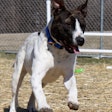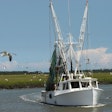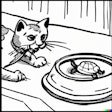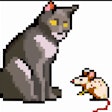
Dogs don’t need to eat like wolves, but pet dogs may benefit from digesting like their undomesticated cousins, providing another reason for protecting wolf populations. The gut microbiome of wild wolves may contain species that could help resolve pet dogs’ digestive problems. In the gastrointestinal tract of a grey wolf (Canis lupus), Oregon State University - Cascades (OSU) researchers discovered a variety of Paenibacillus bacteria with properties that could make the microbe an effective probiotic for pet dogs suffering from inflammatory bowel disease.
“Our Paenibacillus sp.ClWae2A inhibited the growth of Staphylococcus aureus, Escherichia coli and Micrococcus luteus,” study co-author Bruce Seal, Ph.D., a biologist at OSU - Cascades, told Petfood Industry in an email. “This indicates the bacterium may be capable of competitively excluding various pathogenic bacteria in the gut. The isolate’s genome encodes several germination and sporulation gene products, so it could potentially be distributed as a spore formulation. Also, its genome encodes antimicrobials such as a bacteriocin system and chitinase that contribute to its ability to eliminate pathogenic bacteria and fungi. Finally, the bacterium’s genome encodes enzyme genes such as alpha-amylase, cellulase, lipases and pectin lyase indicating it can breakdown nondigestible carbohydrates such as various complex carbohydrates and lipids adding to increased energy for the host.”
To conduct their study, Seal’s team collected material from a wolf’s gut one day after the animal died from injuries caused by being struck by a car. The team isolated 20 gut bacteria species that preliminary genetic analyses indicate may have probiotic qualities. The scientists performed whole genome sequencing on the novel Paenibacillus strain ClWae2A. That bacteria could help pet dogs restore gut microbiome biodiversity lost during domestication. They published their results in Applied Microbiology.
“Possibly because lifestyle changes that occurred during human and animal evolution such as diet have resulted in a deviation from the ancestral state that includes a depletion of the gut microflora,” Seal said. “That has potentially included impacts on increased inflammatory bowel disease among humans and domestic dogs.”
While the bacteria shows promise as a probiotic, the microbe will need more testing before it can be commercialized, he said. His team also identified four or five more strains of wolf gut bacteria with potential as dog probiotics.
“This is based upon characteristics such as the ability of our newly isolated strains to inhibit the growth of Staphylococcus aureus and that the 16S rRNA gene (small ribosomal RNA gene) sequencing of these bacteria indicate they are members of a genus that are known probiotics that are used in commercial formulations for humans and animals,” he said. “Our whole genome sequence (WGS) analyses will help determine if we have unique bacterial isolates compared to other known bacterial types that could be developed as new, unique probiotics.”
The potential benefits for pet dogs points out an economic value of protecting and restoring wild wolf populations. Like many human medicines derived from nature, wild wolves provide an opportunity to develop treatments for ailing pet dogs.
“This research, like other similar efforts, clearly demonstrates the importance for protecting and maintaining our planet’s biodiversity,” Seal said. “We can continue to “mine” the microbiota of endangered species to advance discovery of new microbes that can be utilized to improve the health and well-being of humans and our domesticated species of both animals and plants.”
Wildlife conservation differentiates pet food brands
From previous reporting: Habitat restoration and conservation efforts can play a role in pet food companies’ sustainability and corporate social responsibility plans. For example, Mars Petcare’s Sheba brand expanded its efforts to restore coral reefs from Indonesia to Hawai’i.
“In partnership Kuleana Coral Reefs, the SHEBA brand is working to restore and protect Hawai`i’s coral reef ecosystem to help ensure the future has more fish for everyone,” a Sheba brand spokesperson told Petfood Industry. “By showing the world that there’s a man-made solution to this man-made problem, that can be implemented at scale, we hope to inspire others, drive momentum, and demonstrate that it is possible to have a plentiful, sustainable fish population for years to come…Kuleana Coral Reefs is dedicated to restoring Hawai`i’s degraded coral reefs to cultivate resilient marine ecosystems, as well as to developing affordable and scalable techniques that are supported through the SHEBA brand’s partnership. With support from the brand, Kuleana Coral Reefs has been able to accelerate their plans, already expanding from 10 to 30 sites across the broader archipelago, now in O’ahu and Maui.”
Sheba started its coral restoration program with Hope Reef in Makassar, Indonesia, in 2021. Hope Reef began as interconnected underwater structures, called reed stars, spelling out the word hope. Since then, coral growth has increased from less than 2% to over 70%, and fish populations have increased by 260%, along with a 64% rise in the variety of species, according to Sheba. The reef stars were handmade in nearby communities using locally available materials.
“So far, 840 reef stars have been laid on Hope Reef, helping grow 42 species of coral,” a spokesperson for Mars Petcare told Petfood Industry. “More than US$16 million has been invested in research, builds, and community engagement over the last 15 years from both the brand and Mars. Our holistic solution to reef restoration is called the Mars Assisted Reef Restoration System – MARRS. We carefully choose sites where restoration is both necessary and an appropriate solution; we work with local communities to establish sustainable programs; and we monitor our restored reefs regularly to ensure positive whole-ecosystem impact.”
Pet owners and wildlife conservation
People who care about pets tend to care about animals in general. Sometimes pets lead people to appreciate wildlife in revolutionary ways, as with Jane Goodall and her childhood pet dog. Goodall’s experiences with her pup led her to question the prevailing notions of her time about animals’ minds. The chimpanzees that Goodall studied in Tanzania were following in the pawprints of her pet dog. Once a person develops a relationship with a pet, they have a window into the emotions and cognition of all animals.
“A shared love of animals creates a common bond,” Lorie Westhoff, senior director of corporate PR at Nestlé Purina, told Petfood Industry. At the St. Louis Zoo, Purina helped fund the creation of the African Painted Dog habitat in the River’s Edge expansion project. The company also funds conservation organizations like Ducks Unlimited and Pheasants Forever.
While pets’ experiences of the world help us understand how other creatures think and feel, the actual experiences of most wildlife are very different from those of coddled pets. Along with the need to survive without regular feedings or sleeping in a house, many animals face threats to their survival as species. Many scientists recognize that a mass extinction event is occurring worldwide. Unlike previous mass extinctions caused by asteroids or other calamities, the current extinctions result primarily from human activities. Deforestation, pollution, invasive species and numerous other causes drive more species to extinction each year.
Meanwhile, as native species have declined, those creatures that became part of human culture thrived and spread. During the Consumer Analysts Group of New York (CAGNY) conference on Feb. 22, one pet food company executive used an analogy to exemplify how his company had capitalized on pet owners’ sentiments. Todd Cunfer, Freshpet’s CFO, compared the evolution of dogs from wolves to the evolution of his frozen fresh pet food from conventional brands.
“Fifteen thousand years ago, there were about two million grey wolves on this planet, and there are virtually no dogs,” Cunfer said. “Most of you probably know that the dogs evolved from the grey wolf. But there are no dogs about 15,000 years ago. Fast forward to today. There are about 800 million dogs on this planet, and only about a quarter of million gray wolves. The dog was that adaptation. They changed and thrived and succeeded and the gray wolf didn't change. And the gray wolf has shrunk. Dogs succeeded and thrived because of their connection to humans who came to dominate this planet.”
To help those dogs and cats that accompanied humanity on its journey to global domination, pet food companies donate food, money and other resources to shelters. However, pet food companies can also protect the homes of those domesticated animals’ wild cousins. Shelters certainly need the donations, and there is no reason to stop the generosity. Pet food companies are ideally placed to help dogs and cats in shelters, so it’s understandable why they would step in with donations of food and other supplies. These donations ultimately serve the pet food companies too. Pet owners tend to stick with the pet foods they start with, and that may mean the brand a new pet is accustomed to at a shelter. Donating a dog’s rations in the kennel may encourage later sales of that dog food. While helping wild animals doesn’t have a direct connection to sales, conservation efforts boost a pet food company’s reputation. Sustainability resonates with pet owners, and protecting the natural world could help brands differentiate themselves in a crowded market. Pet food companies could even help the wolves.
“The Endangered Wolf Center has collaborated with pet food companies throughout its 50-year history,” Kimberly Larson, director of development for the Endangered Wolf Center in Eureka, Missouri, USA, wrote in an email. “We are always in search of new additional partnerships to help feed our growing pack of endangered animals, including our wolves, foxes, maned wolves and African painted dogs. A partnership can come in the form of donations of food, funding or event sponsorships.”
However, when she says food, she doesn’t mean standard kibble. Contrary to marketing claims, dogs and wolves don’t eat alike, no matter how far the whole-prey, high-protein, raw meat trends go.
“At the Endangered Wolf Center, we feed our wolves a mixed diet to mimic their wild diet, which is different than typical dog food,” Larson said. “We partner with the Certified Bow Hunters of Missouri to feed our wolves whole prey, such as deer, and supplement their diet with Mazuri Exotic Canine Chow.”
Although not formulated to feed the wolves themselves, pet foods can give something back to dogs' relatives in other ways.
“Wolves are misunderstood, with a long history of being villainized in folklore," she said. "One of the most simple and essential ways to aid wolf conservation is to share the truth about wolves. The truth is, nature depends on apex predators and keystone species to survive and thrive. Wolves are both, which is why the wild needs wolves.”
















